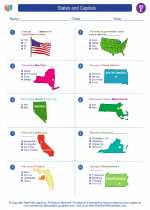States and Capitals -> vernacular regions
Vernacular Regions
Vernacular regions, also known as perceptual regions, are areas that are defined by people's beliefs, feelings, and attitudes. These regions are not officially designated or defined by boundaries, but rather they are based on the perceptions and experiences of the people who live in or visit the area.
Characteristics of Vernacular Regions
- Subjective Boundaries: Vernacular regions do not have clearly defined boundaries and are not based on official or scientific criteria. Instead, they are based on the perceptions and opinions of the people who identify with the region.
- Cultural Identity: Vernacular regions are often tied to cultural identity, shared traditions, and common experiences among the people who live in the region.
- Emotional Connection: People who identify with a vernacular region often have a strong emotional connection to the area, and they may feel a sense of belonging and attachment to the region.
- Perceptions of Place: Vernacular regions are based on how people perceive and interpret the characteristics, features, and qualities of a particular place.
Examples of Vernacular Regions
Some examples of vernacular regions include:
- The American South: Many people identify with the cultural traditions, cuisine, music, and dialect of the southern United States, creating a vernacular region with a strong sense of cultural identity and shared experiences.
- Tuscany, Italy: The region of Tuscany is often perceived as a vernacular region due to its association with rich history, art, and a romanticized rural lifestyle that has been portrayed in literature and films.
- The Rust Belt: This region in the United States is characterized by a shared industrial history and economic decline, leading to a distinct perception and identity among its residents.
Study Guide
When studying vernacular regions, consider the following key points:
- What are vernacular regions, and how do they differ from formal regions?
- What factors contribute to the perception and identification of a vernacular region?
- How do vernacular regions influence cultural identity and the sense of belonging for the people who identify with them?
- Provide examples of vernacular regions and discuss the characteristics that define them.
- Consider the role of media, literature, and popular culture in shaping the perception of vernacular regions.
Understanding vernacular regions is important for recognizing the significance of cultural identity, perceptions of place, and the influence of human experiences on the way we define and understand geographical areas.
.◂Social Studies Worksheets and Study Guides Fifth Grade. States and Capitals
Study Guide States and Capitals
States and Capitals  Worksheet/Answer key
Worksheet/Answer key States and Capitals
States and Capitals  Worksheet/Answer key
Worksheet/Answer key States and Capitals
States and Capitals  Worksheet/Answer key
Worksheet/Answer key States and Capitals
States and Capitals 

 Worksheet/Answer key
Worksheet/Answer key
 Worksheet/Answer key
Worksheet/Answer key
 Worksheet/Answer key
Worksheet/Answer key

The resources above cover the following skills:
Geography: A student should be able to utilize, analyze, and explain information about the human and physical features of places and regions. A student who meets the content standard should:
Understand that a region is a distinct area defined by one or more cultural or physical features.